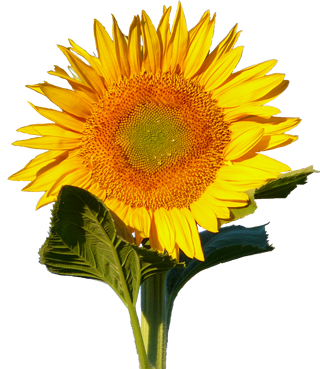
Garden and Plate
The Molecular Biology of Nutrition
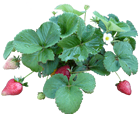







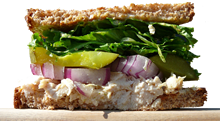

What happens when you combine chlorine (a poisonous gas) with sodium (a toxic metal)? You get table salt (sodium chloride), a crystal that dissolves into two essential nutrients. How are two toxic substances transformed into nutrients? They combine as atoms, and separate as ions.
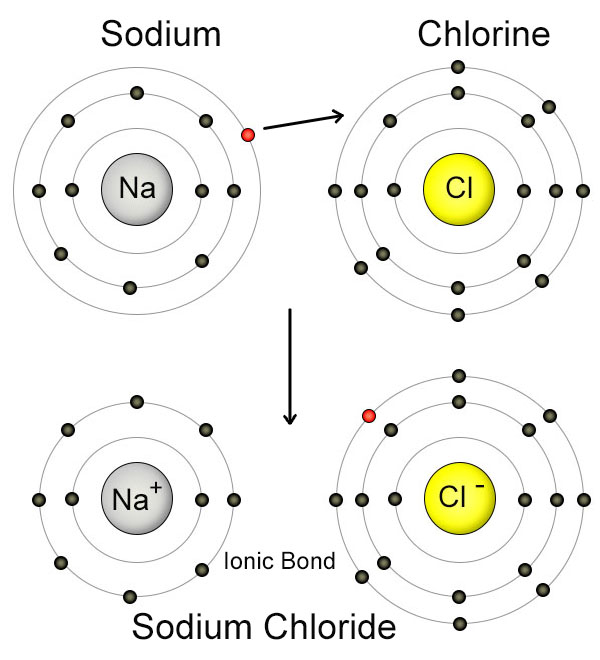
When sodium and chlorine atoms come together to form sodium chloride (NaCl), they transfer an electron. The sodium (Na) atom transfers one electron to the chlorine (Cl) atom, so that they both have full outer shells. With filled outer shells they are no longer chemically active and can't form covalent bonds to become part of a molecule. With the transfer of the electron, however, they become electrically charged, and combine into salts through the formation of ionic bonds.
The sodium ion now has only ten electrons, but still has eleven protons. This upsets the balance of charges between the protons and electrons, which causes the sodium atom to have a net positive charge. When this happens, the atom is called a positive ion. The chloride ion now has eighteen electrons and seventeen protons, so it's become a negative ion.
Because the sodium ion has a positive charge, and the chlorine ion has a negative charge, they are attracted to each other, and form an ionic bond. Ions form salts, not molecules, but they perform many important functions in nutrition.
Sodium and chlorine are both very reactive in their pre-ionic states. They will transfer electrons and (in dry conditions) form salts when they encounter each other. Each one will react with other elements if they don't find each other first, so they are seldom found in nature in their reactive states.
They usually arrive on our plates together as table salt (or it's dissolved ions). In our bodies, however, they aren't bound together as salt, but dissolve back into individual ions in water. And while they complement each other in many biological processes, they also have their separate roles to play.
We've already seen what happens when sodium and chloride combine. Now we'll look at each of them individually. First we'll examine them as reactive atoms, and see why they are toxic in this state. Then we'll look at them in their ionic form and find out why they have nutritional value.
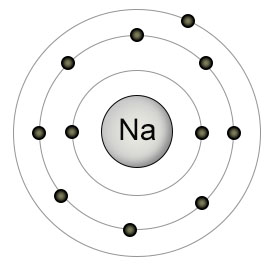
When most people think of sodium, they think of table salt. While table salt contains an ionized form of sodium (in combination with chloride), non-ionized "metallic" sodium has a very different set of chemical properties than the sodium ions in table salt. We examine the chemical properties of sodium in its reactive (toxic) state here, and look at sodium in its ionic (nutritional) state in the next section.
The sodium atom (Na) has eleven protons and eleven electrons, giving it a neutral (balanced) electrical charge. It has only one electron in its outer shell, however, which makes it chemically reactive. To be chemically stable it needs to have a full outer shell. It's easier to get rid of one outer electron than it is to aquire seven more electrons, so it looks to give up the electron.
The outer electrons of each sodium atom aren't desired by any of the sodium atoms, so a cloud of unwanted electrons form. The random motion of the electrons in this cloud cause shifts in the electrical properties of the individual atoms, which in turn cause the atoms to be mildly attracted to each other. These small electrical imbalances initiate metallic bonding at room temperature, causing the atoms to clump together into a soft metal you can cut with a knife.
The combination of metallic sodium atoms with each other is relatively uneventful. To understand why metallic sodium is so reactive, let's see what happens when it comes into contact with water.
Water (H2O) is a molecule consisting of two hydrogen atoms covalently bonded to an oxygen atom. These bonds are formed because the oxygen atom needs two electrons to fill its outer shell, and each hydrogen atom needs one electron. The formation of the water molecule conveniently fills the outer shells of all three atoms, which is why water molecules form from the two gases.
The molecular bonds formed by the hydrogen and oxygen atoms in water are so weak they often break apart due to random thermal energy. So when sodium wants to get rid of its extra electron, water is an easy target. One of the hydrogen/oxygen bonds in water is easily broken, and the sodium atom donates its unwanted electron, filling the vacated space in oxygen's outer shell. Because the donated electron moved from a high energy state around sodium to a lower energy state around oxygen, extra energy is released. This ScienceFix video shows how explosive the chemical reaction can be.
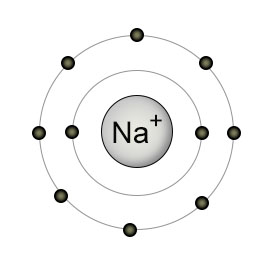
Table salt contains sodium in its ionic form. That's why it doesn't explode on contact with water, and why it has nutritional value. It complements the chloride ion because they have opposite charges which balance each other in many biological processes. Sodium also complements potassium, because while they are both positive ions, they are also chemically different. The chemical differences between sodium and potassium are useful in controlling diffusion across our cell membranes, while the electrostatic differences between sodium and chloride are important in maintaining an electrical imbalance across those same cell membranes. To see how sodium uses these differences to enable signal transmission in nerve and muscle cells, see the article on diffusion.
Sodium is an essential nutrient in animal cells, but it's possible to get too much of a good thing. While low sodium levels can cause muscle cramps due to nerve and muscle cells not being able to control signal transmission and reception, too much sodium can cause problems like high blood pressure.
When we consume sodium, it's absorbed into the bloodstream and extracellular spaces. While it's normal for the extracellular spaces to have a much higher concentration of sodium than is found inside the cell, (the imbalance is used for signal transmission), it can be taken too far. If too much sodium builds up in the bloodstream and extracellular fluids, it will dilute water concentrations outside of the cells. Water will diffuse from high concentrations inside the cell to the lower concentrations outside of the cell, including the bloodstream. This causes cell dehydration and higher blood pressure.
When water flows out of nerve cells that are located in the hypothalamus, osmoreceptors in those cells trigger the thirst sensation. By drinking water, we dilute the sodium in the bloodstream, which reverses the flow of water back into the cells. The kidneys monitor sodium levels in the bloodstream and eventually remove the excess sodium and water, placing them in the urine. Despite this corrective process, routine overconsumption of sodium can result in chronic high blood pressure, since the kidneys can only compensate so much.

The center of the chlorine (Cl) atom contains seventeen protons which are surrounded by seventeen electrons, giving it a neutral (balanced) electrical charge. It has seven electrons in its outer shell, and needs one more, which makes it chemically active. It will fill its outer shell by pairing up with other chlorine atoms to form small molecules, but these covalent bonds are weak and chlorine will abandon them when it comes into contact with an element from which it can steal an electron. Due to its chemical properties it's a gas at room temperature, making it especially dangerous. It's so toxic when inhaled, it was used as a chemical weapon in the first World War. We use it today in small amounts as a disinfectant.
When a chlorine atom comes into contact with a hydrogen atom it forms a molecule of hydrogen chloride (HCl). This enables chlorine to fill its outer electron shell with hydrogen's electron, but hydrogen's nucleus (a proton) also comes along for the ride. When hydrogen chloride comes into contact with water (H2O) it transfers the proton to the water molecule, which creates two charged molecules (HCl becomes Cl-, and H2O becomes H3O+). These two molecules dissolve into additional water molecules to form a highly acidic solution called hydrochloric acid. If chlorine gas is inhaled into the lungs, it will combine with hydrogen (from water molecules) to create hydrogen chloride, and then react with water to form hydrochloric acid, causing severe damage. If hydrogen chloride is excreted into the stomach, it combines with water to form hydrochloric acid, an aid to digestion. What's the difference between a toxin and a nutrient? Sometimes it's nothing more than location!
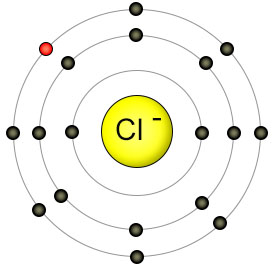
Once you get chlorine into its ionic form (chloride) it offers many nutritional benefits. As a negative ion, chloride not only plays an important role in signal transmission, but also chemically reacts with hydrogen and water to create hydrochloric acid, a solution that helps with digestion.
Hydrochloric acid is created when Parietal cells that line the stomach use the chloride ion (Cl-) as an aid to digestion by combining it with a hydrogen ion (a proton, H+) to become hydrogen chloride (HCl). When the parietal cells secrete the hydrogen chloride into the stomach, it chemically reacts with water. In this reaction the hydrogen chloride breaks back down into the chloride ion by transfering its proton to the water molecule. The water molecule (H2O) becomes a hydronium ion (H3O+) when it gains the proton. In the presence of additional water in the stomach, these two oppositely charged ions (chloride and hydronium) stay dissolved. This combination of water, chloride and hydronium forms the solution called hydrochloric acid. Hydrochloric acid is the main ingredient of gastric (stomach) acid, which digests our food. Gastric acid's low PH level (about 1 or 2) denatures (unfolds) the proteins in our food so that enzymes in the stomach can break apart (digest) the bonds that hold the amino acids together.
Chloride (a negative ion) also interacts with sodium and potassium (both positive ions) to create and maintain the electrostatic imbalances which make signal transmissions and the transport of nutrients across the cell membrane possible. I examine these interactions (including chlorine's role), in the article on diffusion.
Most of the chloride in our diet comes from table salt (sodium chloride), but it's present in a wide variety of foods. In whole foods it's especially high in tomatoes, lettuce and olives.
Table salt (sodium chloride) is a very important part of our diet. In addition to its nutritional qualities, it is used as a preservative and a flavor enhancer. Many of our foods would taste very different without it, even foods that we don't think of as being salty, like bread and milk. It's such an important part of our diet the tongue has evolved a specialized receptor to detect it.
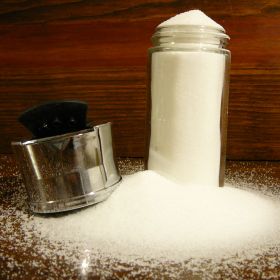
The words salt and table salt refer to two different things. Salt refers to an entire class of chemical compounds that are held together by ionic bonds (in contrast to a molecule, which is held together by covalent bonds), while table salt refers to a specific compound (sodium chloride).
Both sodium and chloride (in ionic form) combine with other substances into other kinds of salts like potassium chloride or sodium bicarbonate (baking soda). Salts can also be created from elements that don't include either sodium or chloride.

The weak ionic bonds between sodium and chloride are dissolved by the stronger polarity of the water molecule, so sodium chloride doesn't exist as a salt inside the body. While sodium and chloride interact with each other in our bodies, they act as separate elements. Their nutritional value is derived not only from their ability to react with each other, but also with other atoms or molecules. These characteristics make processes like the regulation of fluid pressures and the transmission of electrical impulses possible.
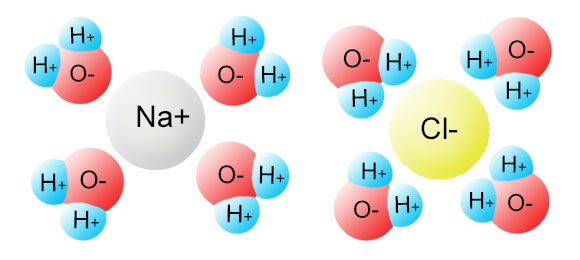
The presence of chloride, potassium and sodium in the right proportions creates an environment that enables the cell to perform it's biological functions. This is one of the reasons they are an essential part of animal diets. Sodium, however, isn't an essential nutrient for plants. While plants can (and do) use sodium when it's available, they prefer potassium. Both sodium and potassium are positive ions, so potassium can fill in for sodium when it comes to functions like electrostatic charge. Yet they still have significant differences in their chemical properties.
We need sodium to setup concentration gradients for the transmission of signals in nerve and muscle cells. Plants don't have these types of cells, so they don't need sodium for signal transmission. Animals use sodium/potassium pumps to decrease fluid pressure levels inside their fragile cell walls to keep them from bursting. Plants, on the other hand, have thicker cell walls that not only stand up to the extra pressure, but count on it to help maintain structural integrity (that's why leaves wilt when they don't get enough water). Plants use proton pumps instead of sodium/potassium pumps to maintain proton gradients, so they don't depend on sodium for any critical processes.
Even more important is sodium's toxic effect on plants. Sodium is toxic for both animals and plants in high concentrations. While animals can compensate for high levels of sodium intake by removing it from their body through the kidney, plants don't have that option. In addition, animals can stop consuming sodium, while plant roots automatically absorb it from the ground during water uptake. If sodium is in the soil in large amounts, the plant will have no way of not absorbing it, and no easy way of getting rid of it once it's absorbed.
High enough levels of sodium will pull water out of cells, which is deadly for all living things. That's how it works as a preservative. Beef jerky doesn't spoil if kept dry because bacteria can't maintain enough moisture inside their cells to procreate in the presence of that much salt. That's also why people can't survive on sea water. Our kidney can remove excess salt, but only by flushing it out with water. The sodium content of sea water is so high, it requires more water to flush it out than is contained in the sea water. It makes up the difference by using water from your body, which dehydrates you.
Plant roots use osmosis to bring water up into the plant. That's another reason why too much sodium in the soil is bad for plants. Sodium reverses the direction of osmosis, pulling water back out of the plant and into the soil.
For all of the above reasons, all fresh fruit and vegetables are low in sodium, and many are high in potassium. Canned vegetables have lots of sodium because it's added later when processed to make it taste better. The plant didn't put it there.